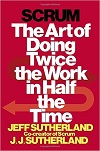Book Review: Scrum by Jeff Sutherland

“I truly believe that if you take care of your employees, they will take care of your business.” – Sir Richard Branson
If Branson is to be believed, and his track record at The Virgin Group suggests that he knows what he’s doing, we’re left with the question: how do you take care of your employees? What do employees want and value in their role in an organization?
According to Abraham Maslow’s Hierarchy of Needs, once the basic and most physiological needs of food, shelter, safety, etc., are met, people long for a sense of belonging, esteem, and ultimately self-actualization.
What that means in practical terms is that employees who feel that they work in a stable environment and are fairly compensated within the organization and within the broader context of their industry, look to factors beyond salary for contentment. Employees want to belong to a team where they feel like they can contribute effectively, where they have some say-so in the work that they do, and where they feel that their work is meaningful.
So how do we create an environment like that – an environment where employees want to do their best work?
That was the question that Jeff Sutherland researched and contemplated extensively during the 80s and 90s. He experimented with countless technical teams.
Until that point, the standard approach to software development was the waterfall method. Waterfall has a terrible track record for producing quality products, in a timely manner, within budget, and that fulfills the customer’s needs at the time of delivery. Additionally, Sutherland observed that the traditional waterfall approach meets almost none of the higher level needs described by Maslow.
He looked for a new approach and identified some philosophies that addressed the shortcomings of the waterfall methodology. He eventually created a set of principles that he later called Scrum.
These principles include:
- Process control – being mindful of the process and continually looking for ways to improve.
- Self-organization – those doing the work have the best awareness of the effort it will take to complete it. Teams will have more commitment when they can contribute to how and what gets done.
- Collaboration – The team works together to accomplish a goal. Teams of 3 to 9 people who have all of the requisite skills to complete the project are preferred.
- Value-based priorities – Teams should strive to create value early in the project, knowing that 80% of the value is derived from 20% of the effort.
- Timeboxing – Break work into discrete units that can be completed in a relatively short amount of time.
- Iterative development – repeat the development process frequently, always looking for ways to improve the process.
Since it’s creation, scrum has been adopted by a wide variety of teams. It’s been used in education, home remodeling, engineering, and medicine.
 In his book Scrum: The Art of Doing Twice the Work in Half the Time, Sutherland explains “the how”, but much more importantly “the why” of the Scrum methodology.
In his book Scrum: The Art of Doing Twice the Work in Half the Time, Sutherland explains “the how”, but much more importantly “the why” of the Scrum methodology.
I borrowed the e-book from my local library. It’s good enough that I’m buying a paper version for reference. I’d certainly recommend reading a copy. Even if you don’t use Scrum at work, you’ll gain a greater appreciation for the factors that motivate your team.


Recent Comments